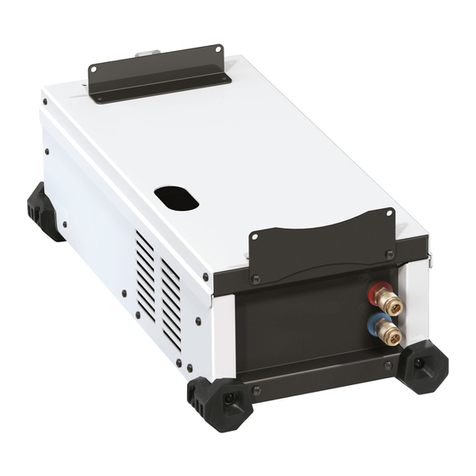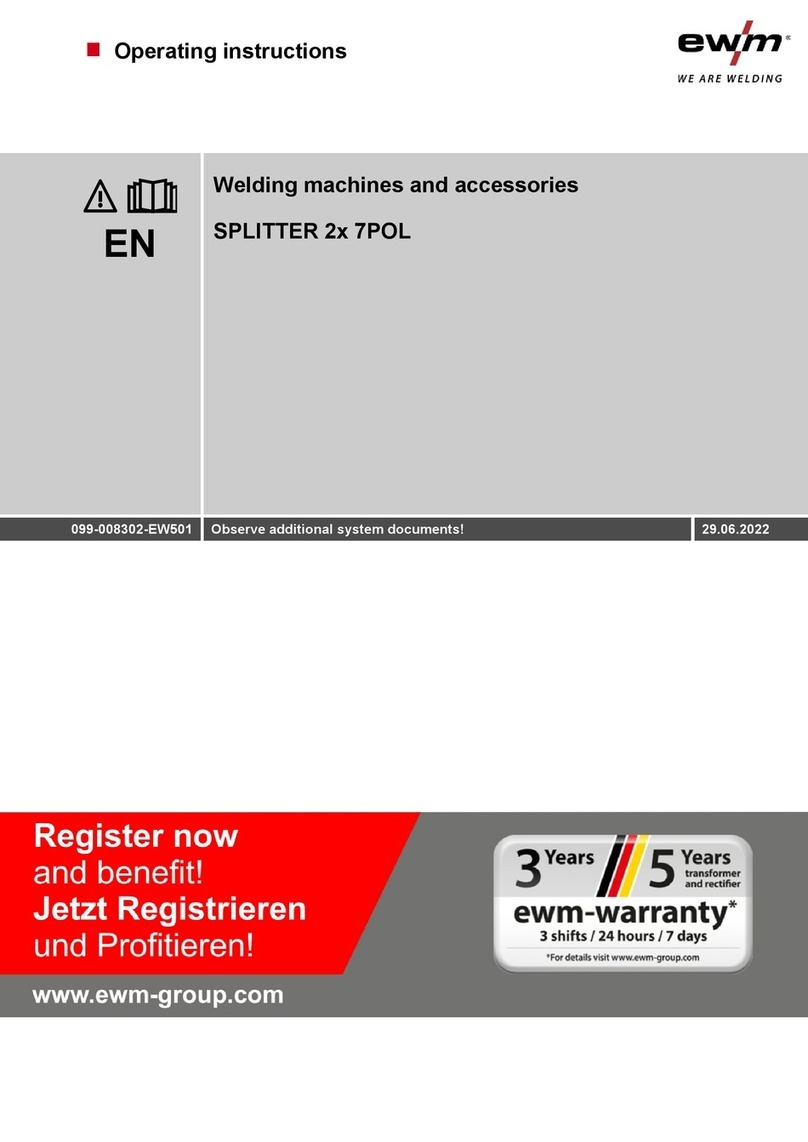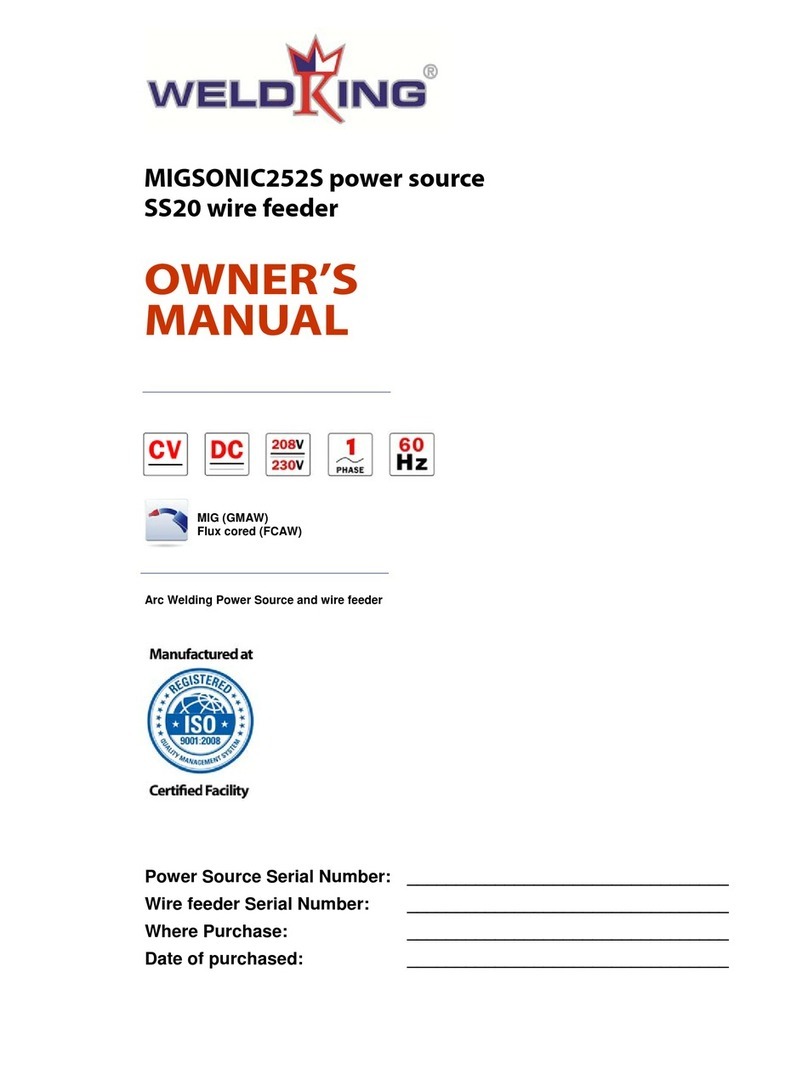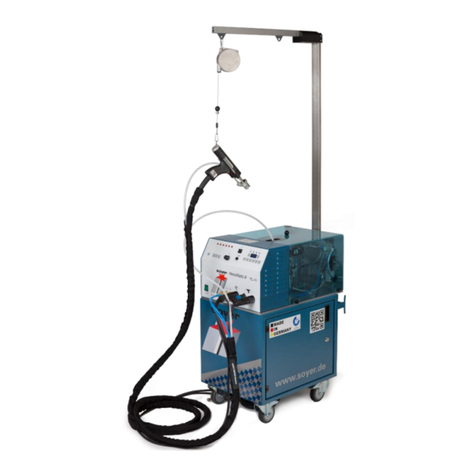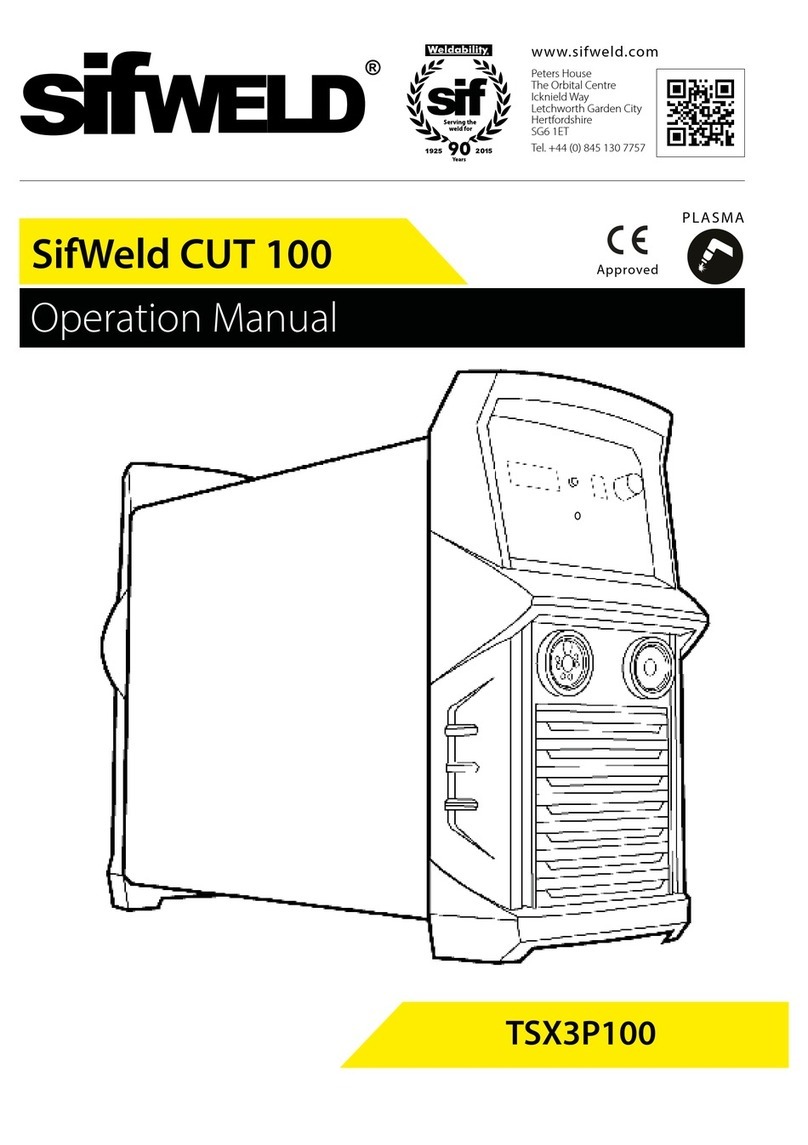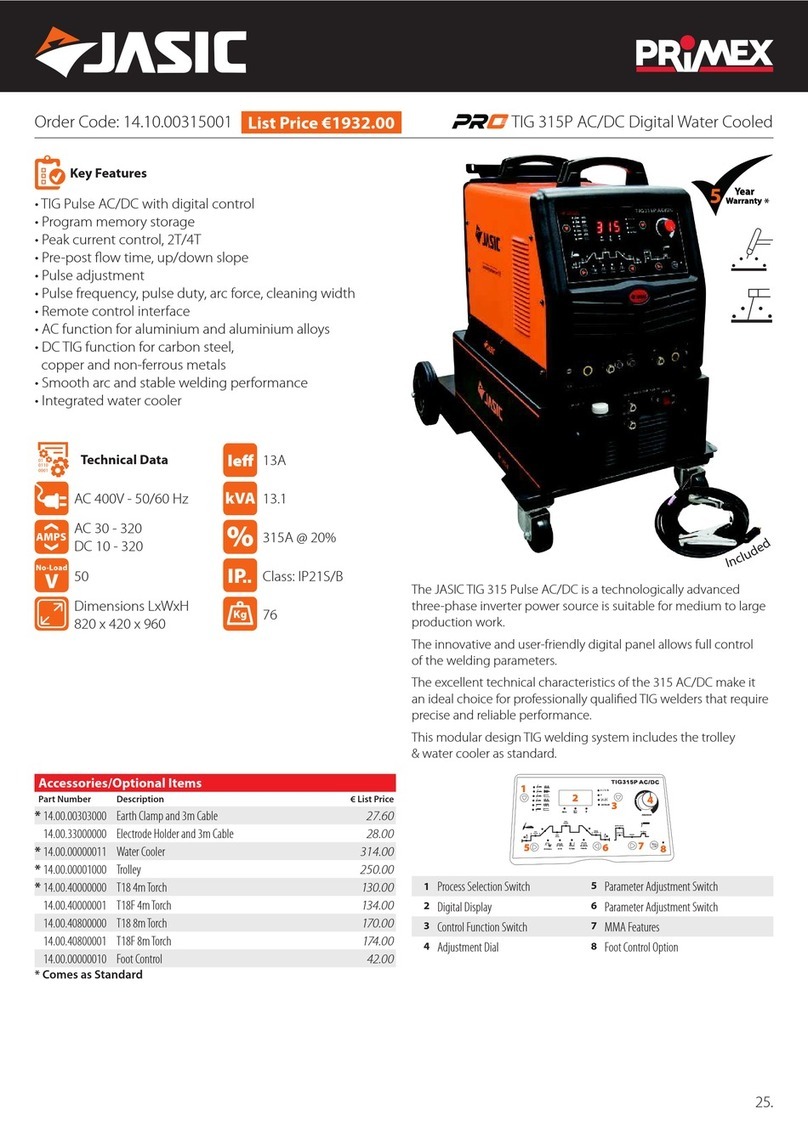GOODWIN P30U User manual

P30U Instruction Manual Revision : 1 1st December 2006 Page 1
OPERATION MANUAL
for the
GOODWIN P30U
UNDERWATER
AIR PLASMA CUTTING SYSTEM

Page 2 P30U Instruction Manual Revision : 1 1st December 2006
TheCompanyreservestherighttomakesuchchangestothedesignorspecificationofthe
equipmentasitshallseefit. The informationcontainedinthis manualisissuedfor theguidanceofusers
anddoesnotformpartof any contract. It is strongly recommended that allusersandsupervisors
familiarisethemselveswiththecontents...
PRIOR TO COMMENCING USE OF THE SYSTEM
...andinparticular,the section on safety precautions which should be used asaguidetosafe
operationin accordance with therequirementsoftherelevantHealth and Safety atWorklegislation.
GOODWIN AIR PLASMA LIMITED
KERNAN DRIVE
LOUGHBOROUGH
LEICESTERSHIRE
LE11 5JF
ENGLAND
Tel No. +44 (0)1509 237369
Fax No. +44 (0)1509 234942
Email. [email protected]

P30U Instruction Manual Revision : 1 1st December 2006 Page 3
Contents
1................................................................................................................................................. SAFETY 4
1.1................................................................................................................................................General 4
1.2.................................................................................................................................. Safety Features 5
1.3.................................................................................................................................... Warning Signs 5
1.4................................................................................................ Packaging Handling and Transport 5
2........................................................................ INTRODUCTION TO THE PLASMA PROCESS 6
3.................................................................................................................................INSTALLATION 7
3.1......................................................................................................................................Power Supply 7
3.2..........................................................................................................................Earth Requirements 7
3.3........................................................................................................................ Phase Determination 8
4......................................................................................PLASMA AND TORCH CONNECTIONS 9
4.1.............................................Connecting the Torch and Plasma Earth Lead to the Power Unit 9
4.2........................................................................................................................ Control of theTorch 10
5 ...................................................................................................................................... OPERATION 11
5.1............................................................................................................................Machine Controls 11
5.1.1 .........................................................................................................WARNING INDICATORS 13
5.2.......................................................................................................................Power Up Procedure 14
5.3...........................................................................................................................Cutting Procedure 15
5.3.1. ....................................................................................STARTING AND FINISHING A CUT. 15
5.3.2. .............................................................................................. CUTTING WITH STAND OFF. 15
5.3.3. .....................................................................................................................CUTTING SPEED. 16
5.3.4. ...................................... PIERCING THICKER MATERIALS WITH A HAND TORCH 17
5.4.............................................................................................................................. Troubleshooting 18
5.5............................................................................................................................ Consumable Life. 18
5.5.1. ..................................................................................................................... INTRINSIC LIFE. 18
5.5.2. ............................................................................................................................ALIGNMENT. 18
5.5.3. ..........................................................................................................TRANSIENT DAMAGE. 18
5.5.4. ................................................................................................... OPERATIONAL DAMAGE. 19
5.5.5. .......................................................................................ELECTRODE “NON-STARTING”. 19
5.6..................................................................................................................Changing Consumables 20
5.4.............................................................................................................................. Troubleshooting 23
5.5............................................................................................................................ Consumable Life. 23
5.5.1. ..................................................................................................................... INTRINSIC LIFE. 23
5.5.2. ............................................................................................................................ALIGNMENT. 23
5.5.3. ..........................................................................................................TRANSIENT DAMAGE. 23
5.5.4. ................................................................................................... OPERATIONAL DAMAGE. 24
5.5.5. .......................................................................................ELECTRODE “NON-STARTING”. 24
6..........................................................................................................................TECHNICAL DATA 25
6.1........................................................................................................................................Power Unit 25
6.1.1. ..............................................................................................................ELECTRICAL INPUT 25
6.1.2. ........................................................................................................................ Electrical Output 25
6.2........................................................................................................................ Torch and Hose Set 25
6.2.1 ........................................................................................................................... HAND TORCH 25
7. ............................................................................................................ SERVICE INFORMATION 26
7.1................................................................................................................................The Power Unit 26
7.1.1. .......................................................................................................................... Circuit Diagram 27
7.1.2. ................................................................................................................MACHINE LAYOUT 28
7.1.2. ................................................................................................DIAGNOSTIC INDICATORS. 30
7.2................................................................................................... The Torch and Hose Set Repair 31
7.3.................................................................................................................................... Maintenance 32

Page 4 P30U Instruction Manual Revision : 1 1st December 2006
1. SAFETY
1.1 General
Before any cutting operations are started, the user must ensure that the installation and proposed
working methods comply with all relevant safety regulations, environmental and electricity standards.
The plasma arc produced at the torch head is a jet of high energy and is potentially dangerous. Users
unfamiliar with a plasma arc should seek basic training. Goodwin Air Plasma can offer comprehensive
training courses.
Inaddition, the following points areparticularly important:
a) The mains connection must be properly grounded and the supply lines fitted with fuses or circuit
breakers of the specified rating. The mains cable must be properly secured and protected from possible
damage.
b) High voltage exists at the torch when power is applied and the pilot arc is struck (up to 350V), and
when the main arc is cutting (150-200V). Under no circumstances should anyone touch the nozzle with
power applied to the torch. All adjustments and replacement of parts should be done with the power unit
supply isolated. The standard torch should not be used in excessively wet conditions or if the torch or hose
set are damaged in any way.
Note that the PTU torch, its umbilical and associated extensions and connectors are designed to be used
underwater. The current specification is to a maximum of 30m, although it has been tested to a simulated
70m..
The electrical connectors are underwater mateable (to ocean depth) but in practice it is not advisable to
disconnect the coolant and air lines underwater, so this would normally be done on the surface.
c) The mains supply should be isolated from the unit AT THE SUPPLY before removing any panels
from the unit. Only authorised service personnel should remove panels.
d) Keep the work area clear of all inflammable materials. Ensure that any material ejected from the cut
is not a hazard to the operator or to others.
e) Protection is necessary against ultraviolet radiation emitted from the arc. A helmet or shield with
shade glass is recommended. Note, however, that the plasma arc does not usually need to be observed
closely, if at all. It is more often necessary to be able to see the material surrounding the cut, so a lighter
shade than that used for welding will probably be required. Furthermore, when cutting underwater, the UV
is absorbed by the water to a considerable degree. Wear gloves and adequate protective clothing where
appropriate.Adequate screening should be arranged to protect others in the vicinity or passing by in a similar
manner to that required for arc welding operations.
f) Adequate ventilation or fume extraction to remove the cutting fume and dust is required at all times
around any plasma cutting operation.
g) The wheels on the unit are meant for ease of movement around the work place and should not be
used over rough surfaces nor at excessive speeds.
h) The plasma power unit should be positioned on stable level ground and if necessary secured against
any unwanted movement.
i) The operation of this equipment and the plasma cutting process can result in noise levels that could be
harmful. When cutting underwater the noise level from the arc is substantially reduced and does not represent
a risk to the diver. The employer should undertake a noise assessment to monitor compliance with relevant
legislation.
j) Material to be cut should be supported in such a way that any material cut from the work piece will
not be a hazard and fall onto the user, the equipment, or others in the vicinity.
k) Care should be taken when manoeuvring the hose set with either a hand held torch or one connected
to a robotic device, that it does not snag on objects or other equipment which may result in damage to the
hose set, or topple the objects or equipment. Hose sets that are subject to excessive mechanical tension may
result in damage to the hose set connections at the machine, the torch, or the hose set components themselves.

P30U Instruction Manual Revision : 1 1st December 2006 Page 5
1.2 Safety Features
Theplasma unitincludesthefollowing featuresforthesafety oftheoperator:
* Thebodyof the plasma torch isearthed.
* Thecontinuityof the torch earth and the voltage on the body ismonitored.
* Cuttingcurrentflowinginthesupply earthismonitored.
* Thevoltage onthetorchnozzleis monitored.
* Inthe event of a faulty conditionoftheabove,themachinewillswitch off power to the
torch.
Theemergencystopprocedure is to hit the redemergencystopbutton located on the lower front
controlpanel.
Atool(10mmspanner)isrequired to remove the canopy for access totheinternalcomponents.Under
nocircumstances shouldthecanopybe removedwhilstthemains supplyisstillconnected. Onlysuitably
trainedand authorised personnel should remove thecanopy.
1.4 Packaging Handling and Transport
Shouldtheplasmaunitneedtobeshipped,werecommendre-useof the original packing crate.Also:-
a)That the hose setbe disconnected to preventany damage to thehose set / plasmaconnections.
b)Thatthe control panel is adequately protected against potential damage.
c)Any lifting shouldbedoneusingtheeyebolt located in thetopofthecanopytogether with certified
liftingequipment (not supplied). Precautionsshouldbetakentoprevent rotation about theeyebolt.
d)The plasma unit shouldbeshippedandstoredin the upright positiontoavoidanyheavyinternal
componentsbreakingfreefromtheirmountings.
e)Storageshouldbeundercover, preferably in a clean dry environment.
1.3 Warning Signs
Thelocation ofthewarningsigns fittedtotheplasma
unitare:
a) Atthe front of the machine -
WarningOpenCircuitVoltage300volts.
b) Ateach rear lower cornerof the canopy -
WarningDisconnectthe MainsSupply.....
Theseshouldbemaintained inalegiblecondition.

Page 6 P30U Instruction Manual Revision : 1 1st December 2006
2. INTRODUCTION TO THE PLASMA PROCESS
Theplasmaprocess is created by passingastream of clean air,provided by an oil freecompressor,
throughaNOZZLEin the torch.Theairstreamis ionised by a PILOTARC,initiated by aHIGH
FREQUENCYunit (HF Unit) which passes fromtheELECTRODEtothenozzlewhenthe torch is
activated.When the PILOTARC is broughtcloseto the workpiece,MAINARCisTRANSFERRED
tothework piece as a jet of high energy which rapidly meltsanymetalwithwhichitmakescontact,
providingfastcutting,low residualheatinput,andlowmaterialdistortion.
Theelectrodeandnozzlearecooledbytheairandarecirculating water cooling system, and as the air is
passedthroughthenozzleitis caused to swirl around the arc byaSWIRLBUSHtoaid stability of the
arc.
TheHFunitoperates automatically to establish an arcwhenpoweris applied to the torch anditceases
tooperatewhenthepilotor main arc is established.

P30U Instruction Manual Revision : 1 1st December 2006 Page 7
3. INSTALLATION
Maybecarried out by a competentelectrician.No specialist tools are required.
3.1 Power Supply
Thepowerunitisprovidedwithalengthofflexiblecablewhichmustbeconnectedtoa3-phase
andearthelectrical supply.The supply should befittedwithfusesorcircuitbreakersofappropriate
ratingand a means of isolating thepowerunitfromthesupplyshouldbe provided.Aplug should be
fittedifappropriate.Themachine isphase/rotationsensitive.
Thepowerunit has power factorcorrectioncapacitors fitted as standard.It must be noted that
whentheunitderivesitspowerfromagenerator, the power factorcorrectionmaydisturbthegenera-
tors’automaticvoltagecontrol. If recommended by GoodwinAirPlasma,thepowerfactorcorrection
circuitcanbe disconnected however this will increase the input current demand. TheP30Uhasauto-
maticswitching of thepowerfactorcorrectionso that itonlyoperateswhilstcutting, so itisunlikelyto
causethisproblem.Thismaybefittedasanoptiontoothervariants.
Refer to the rating plate on the machine and Technical Data section 6.1.1. for the correct voltage
and current requirements.
3.2 Earth Requirements
Theinstallation should ideally be arranged suchthattheonlypathtoearth(or ground) from the work
pieceisbywayofthe plasma earth lead connected to the frontofthemachine.
Wherethematerialtobecut forms part of the structure which isearthedorgroundedtothe mains
electricalsupply system,thenthecuttingcurrent couldflowthroughthat route ratherthantheplasma
earthleadtothe machine.Always ensure thatthereisa good connection between the workpieceand
themachine via the plasma earth leadasapoorconnectionwillcauseexcessive current in the mains
supplyearth whichwillcreatea currenttripfaultcondition (seesection7.4fault finding).
NotethattheEarthLoopMonitorsystemusedintheunderwatermachinewillensurethatagood
connectionismade.
Ininstallations where it isnotpossibletoavoidearth current trips, eventhoughagoodcutting
currentearthpathhasbeenensured,itwillbenecessarytocheck that the alternative mains earth paths
aresubstantial enough tocarryhighercurrentsthan the currenttripsettingof30amps (*) withoutcausing
damage,aswherethecuttingearthisnotconnectedtotheworkpieceatall,thiswouldbethefullcutting
current.Iftheearthpathsare not substantial they must be uprated orre-routedtoavoidthepossibility of
damage.Oncethenecessarychecksand precautions have been taken, the earth currenttripcircuitmay
bedisabledbymeansoftheswitchontheEarthCurrentRelay (ECR) located inside the power unit.
*Sincethe workpiece will often be substantiallyconnectedtothesupplyearthinunderwater work,
andsignificant currents must beallowedtoflowinseawater to the torchandumbilicalearth,aless
sensitiveearth current relayisused.Thestandard machine sensitivityis10A. Thisshouldavoid most
casesofnuisancetripping,andthe need to disable the ECR.

Page 8 P30U Instruction Manual Revision : 1 1st December 2006
3.3 Phase Determination
Connectthetorch to the machine (seesection4).
Fill the water system with distilled water.
Note.To avoid damaging the water pump the machine should not be run without water in the
system. Also, the machine should not be run for more than a few seconds without a torch connected
to the machine. It may be necessary to eliminate air from the system, and vent the de-ionizing filter,
to establish a proper flow.
Switch on the machine by rotating the main isolator and pressing the on/off button ensuring the
emergency stop switch is unlatched.
Correct phase connection is determined by checking that the cooling air flowing through the power
unit is from the front panel to the rear of machine. If this condition is not correct, change two of the
three phase connections at the power supply and check again. The fan rotation, when viewed from
the front of the machine, is anti-clockwise.
If there is any doubt regarding installation, consult your distributor or GoodwinAir
Plasma.
FanRotationAnti-
Clockwise
Water Tank
De-ionizing
Filter

P30U Instruction Manual Revision : 1 1st December 2006 Page 9
4. PLASMA AND TORCH CONNECTIONS
4.1 Connecting the Torch and Plasma Earth Lead to the Power Unit
Note. Donotrunthepowerunitwithoutthetorchconnected.
Theconnectionstothepowerunit are located at the front of theunit.
The PTU torch and umbilical extensions use a specially designed electrical connector for the power,
safety earth, pilot arc, and all other electrical connections. There is a central pin that carries the
power, a pin for the pilot arc connection and 5 smaller pins for safety monitoring and the diver’s
control switch. The safety earth is made through the locking sleeve. There are four hose connectors,
filled with quick acting connectors.
the blue hose is the cooling water to the torch;
the red hose is the cooling water return from the torch
the black hose carries the plasma air
the yellow hose is a “pneumo” connection to allow the plasma air pressure to
automatically track the working depth
Thewaterconnectionsarenotpolarisedbutitisadvisabletofollowthecolourcoding.
Theseconnectors are found on the machine front paneland replicated at the socket end of the ex-
tensionumbilicals.
Thesupervisor’sremote control panel connects to a multiway socketabovethetorchconnectors.
(Note that this is an “analogue” lamp, therefore it may be illuminated but not at full brightness,
and the indicator (which is “digital”) on the front panel and the supervisors panel still fail to
light because of a poor connection).
Whenfirst switching on, allow enough timeforthewatertocirculatethroughthe system. Top upthe
headertankas required. Use only distilledorde-ionised water. (See section 7.1regardinguse of
methanolinfreezingconditions).
Thetwoearth connectors (insert andtwistclockwise to lock) arelocated on the left handside of
thefrontpanel. An indicator lamp indicates when an earth loop has been successfullymade.

Page 10 P30U Instruction Manual Revision : 1 1st December 2006
4.2 Control of theTorch
Notethatthetorchhasa switch for use by the diver,but that this is used in conjunctionwiththe
supervisorspaneland a communications procedure to energise the torch. The torch will de-energiseif
thediver’sswitchisreleased at any time.
Note that it is good practice to leave the power unit running at all times when the torch
is underwater to prevent the torch and air hose filling with water.
Cooling air will flow through the torch at all times when the machine is switched on.

P30U Instruction Manual Revision : 1 1st December 2006 Page 11
WARNING
INDICATORS
MAINISOLATOR
ON/OFF BUTTONS
EMERGENCYSTOP
OUTPUTONLAMP
AIRPRESSUREGAUGE
AIRREGULATOR
RESETBUTTON VOLTMETER
5 OPERATION
5.1 Machine Controls
Thefrontpanelofthemachine provides a range of displays and controlgeartoensurecorrectoperation
ON / OFF BUTTONS
Switchesauxiliary circuits onandoff.ieCompressor, waterpump,coolingfanandcontrol circuits
MAINISOLATOR
Isolatesmachine from mains supply.Itmaybepadlockedintheoffposition.
EMERGENCYSTOP
Switchesmachine off. The switchlatchesmechanicallyandmustbe rotated to release.

Page 12 P30U Instruction Manual Revision : 1 1st December 2006
HoseConnections
See section 4. Connecting the torch to the power unit.
Voltmeter
Indicatesthearc voltage.
Typicalvalueswouldbe: Powerapplied to torch but no arc 300v (actually off-scale: up to 350V)
ForPilotArc 250 to 300 volts
For MainArc 150 to 200 volts
(Voltageis affectedbysupply voltage, cuttingdepth,cuttingspeedand material thickness)
OutputON LAMP
Indicatesthatpower is applied tothetorch.
ResetButton
Resetsearthcurrent, earth safety,andwaterwarningcircuits.
AirPressure Gauge
Displaystheback pressure in the system during the pilot arc and cuttingmodes
Typicalvalueswouldbe: ForPilotArc 0.7 to 2.2 bar (10 to 30 psi)
ForMainArc 2.4 to 3.4 bar (35 to 50 psi)
Notethat the airregulator tracks theworking depth, thereforethe pressure gaugeshows this operating
pressureplus the working depth (1 bar = 10m= 32 ft)
TrackingAirRegulator
Setstheair flow through the torch togivea stable pilot arc andadjuststo allow for the workingdepth.
Notethat essentialindicators onthe frontpanel, and the reset button,are replicatedon
thesupervisor’spanel, andit isnormally onlynecessary toswitch themachine onoroff
atthepower unit.
Note that the supervisor’s panel and the dual earth system must be used before it is
possible to energise the torch.
Itis possible to usethemachineinaconventional mode for drycuttingintheworkshop(ie single
earthandcontrolbytorchswitch) by use of a special bypass plugfittedtothesupervisor’s remote
controlsocket. Ifsupplied this should not normally be kept with the machine topreventusein
inappropriatecircumstances. Itshould never be used when operating underwater

P30U Instruction Manual Revision : 1 1st December 2006 Page 13
POWER
READY
TEMPERATURE
WATERFLOW
EARTHCURRENT
EARTHSAFETY
PILOTTRIP
EARTHLOOP MONITOR
POWER INDICATOR -
Indicatesthat power is availabletothesystemcontrolcircuit.
READYINDICATOR-
Indicatessysteminterlocks are operational and the machine is ready to cut
TEMPERATURE INDICATOR-
Indicatesthat the rectifierortransformertemperatureis too high.
WATER INDICATOR-
Indicatesinsufficientwaterflowinthe torch.
EARTH CURRENTINDICATOR-
Indicatesexcessivecurrentsinthesupplyearth(seesection3.2).
EARTH SAFETYINDICATOR-
Indicatesabreak in the earth connectiontothe torch or a voltageinexcess of 10 volts tothetorch body.
PILOTTRIPINDICATOR -
Indicatesthe pilot archasexcessivecurrent,due to consumableconditionorinsufficientairflow.
EARTH LOOPENABLED-
This shows that the dual earths are properly connected to the workpiece which will enable the diver's
switch
5.1.1 WARNINGINDICATORS
Seesection7.1.2Displays and Controls for more details.

Page 14 P30U Instruction Manual Revision : 1 1st December 2006
5.2 Power Up Procedure
NOTE.
Asthisplasmapowerunitdoes nothaveavoltagestablisedpowersupply,afluctuation intheinputvoltage
willdirectlyaffecttheoutputcurrent.Thismaynotbenoticeableiftheinputvoltagerisesslightlyabovethe
normasitwillprovidemorepowerforcutting.Iftheriseisexcessive,consumablelifemaysuffer.However,
whenthe input voltage falls,theoutputpoweralsofalls, affecting both thepilotarcandmainarc. In these
circumstances it will be necessary to adjust the air pressure regulator to reduce the airflow to obtain a
stablepilotarc,andreadjustitwhenthemainsvoltagereturnstonormal.
Having completed the mains and cutting earth wiring, connected the torch and checked the fan
rotation,andconnectedthesupervisorspanel,themachineisreadyforuse.
Switchthe machine on and after allowingtimeforthewatertocirculatethrough the torch, press the
resetbuttonon the front panel orsupervisorspanel. The red indicators shouldgoout and the ready light
willilluminate. Note that the supervisors panelwillalwaysneedtobereset,even if the machine has been
resetonthefrontpanel.
To ascertain the absence of air leaks, the air regulator should be wound fully clockwise and the
pressuregauge should indicate aback pressure in excessof 3 bar.
Itisnownecessarytoadjusttheairpressuretogivethehighestpossiblereadingconsistentwithgood
arcstartingand a stable pilot arc,thisshould be at least 0.7bar.Switch on the torch withthenozzle well
clearofanyworkpiece, person or equipment, and re-adjusttheairpressure until it is at maximumorthe
pilotarc becomesunstable(verynoisy,misfire,and thevoltmetershowing300 volts).Atthispointreduce
thepressuretorestore stability (arc less noisy, stable arc, and thevoltmetershowing 250/300 volts).
Alwaysmaintainashighanair pressureaspossibleforpilotarcasthisgivesthebestconsumable life.
Theoutput neon is “on”and the voltmeterreads between 250 vdc and 300 vdcat this stage.
Themachineis now setup and is now ready to be used. Beforestartingacutpleaseseesection1for
safetyinformationandthensection5.3forcuttingprocedure.Thecorrectprocedureforcuttingunderwater
isconsidered morefullyinthe SupervisorsPanelInstructions

P30U Instruction Manual Revision : 1 1st December 2006 Page 15
IMPORTANT
Under normal cutting conditions the torch is designed to
operate with a STAND OFF of about 6 mm. This is the
distancebetweentheendofthenozzleandtheworkpiece.
Underwaterthis will probably be reduced to 2-3mm, say,
bymodifyingtheGuideRing,ifused.
Wheretheworkpieceisrusty, scaly, or with thick sections
ofsteelor aluminium etc., a buildupof dross on the topof
thework piece may occurwhich will cause damageto the
nozzle.In theseconditions,thestandoff distanceshouldbe
increasedslightly.
Aguideringis avalabletoassisttheoperatorinmaintaining
thedesired stand off height. This canalsobeusedagainsta
straightedge tomaintainastraight cut.
5.3.2.CuttingWithStandOff.
5.3 Cutting
Procedure
Wherepossible it isbetter to starta cut ata plate edgeor hole becausethe piercing processreduces
consumablelife.
Cutscanbe started by eitherinitiatingthe pilot arc andmoving the torch into theproximity of the work
piece,orbypositioning the torch over the edgeofthework piece and starting the pilotarc.Underwater,
andespeciallyat depth, it may benecessaryto always start very closetothe workpiece.
Materialswithacapacitytoabsorbheatenergy,especiallythickersections,requiremorecareandtechnique
whenstartingacut.Inthesecasesthecutwillappearslow to start and pierce through the material. Once
acutisestablishedthencuttingspeedsmaybeincreased.
Cuttingcanbestoppedeitherbyreleasingthetorchswitch,oratthesupervisorspanel,orinanemergency
byswitchingoffthepowerunit. It will stop cutting if moved awayfromtheworkpiece,butwill then re-
establisha pilot arc. This is notrecommendedpracticeforunderwatercutting.
5.3.1.StartingandFinishingaCut.
If the arc should “flare”, be coloured green, or emit any unusual noise, it is essential that the torch be
immediatelyswitchedoffandtheconditionoftheconsumableschecked.Thisusually indicates that the
consumablesare damaged or reachedthe end oftheir useful life. Continuing to try andcut under these
conditionsmay result in damage extending beyondtheconsumablestootherpartsofthe torch.

Page 16 P30U Instruction Manual Revision : 1 1st December 2006
5.3.3.CuttingSpeed.
Bestresults areusuallyobtainedbycutting attheoptimumcutting speed.
OPTIMUMCUTTINGSPEED
Correctcuttingspeedisjudgedbyexperiencefrom
observingthe angleatwhichthe cutmaterialleavesthe
loweredgeoftheplate,either by observing the ejected
materialorby studying the surface of a cut after complet-
ingatest cut. The dragbackof the arc isaproximately 30
degrees.
CUTTING TOO SLOW
Arcappears to blow straight through thematerial.
Excessivedross may accumulate ontheundersideofthe
material.
CUTTINGTOO FAST
Arcfailstopiercethematerial.Blowbackofdrosswill
damagethenozzle.
MAXIMUMCUTTINGSPEED
Dragbackofthe arc is around 45°, butcutqualitywill
deteriorate.

P30U Instruction Manual Revision : 1 1st December 2006 Page 17
5.3.4.PiercingThickerMaterialswithaHandTorch
Piercingwillcausecutmaterialtobeejectedupwardswhichcanbedangerous,andhasariskofdamaging
the torch nozzle. This problem is worsened as material thickness increases because it takes longer to
pierce.If itisnecessaryto pierce,thenitis bestdonebyangling thetorchandgradually bringingitupright
aspiercing is completed.
Initiatethepilotarcandlaythetorchoveratapproximately60º
Begintwistingthetorchslowly towardsaverticalpositiontaking
careto avoid ejected materialfromhittingthenozzle.Atthe
sametime,the torch should be moved a small distance along the
workpiece.
Aspiercingcompletes, the nozzle can be brought to vertical and
cuttingcancontinue.
Ifthe torch is pivoted about the nozzle there is a risk ofmaterial
beingblown back ontothenozzlewhichwill cause damagetothe
nozzleor even to the torch itself.
*
Imaginarypivotpoint.X
X
X
X
X

Page 18 P30U Instruction Manual Revision : 1 1st December 2006
Bevelismorenoticeableonthinner sections and is more pronounced on thelefthandsideofa cut. It is
duetothe clockwise swirling of the air induced by the swirl bushintheelectrodeassembly. Bevel edges
canbedesirableasanaidtoweldpreparation,howeveritcanbevirtuallyeliminatedbyreducingthe
cuttingspeedbutattheexpenseofaccumulateddross.Forminimumbevelcutclockwisearounda
componentand anticlockwise inahole.
5.5.ConsumableLife.
Agoodconsumablelifeisthe singlemostimportantfactorinachievingoptimumcuttingeconomicsof
anyplasmacuttingunit. Thislifeisdependentontheintrinsiclife oftheconsumables,correctalignment
andthe incidence of transient and operationaldamage.
5.5.1.IntrinsicLife.
Theintrinsiclifeoftheconsumablesisdeterminedbytherateat which they are eroded by the arc
process.This erosion rate is however low,and in practice, the life is limited by other factors.The insert
inthe centre will beerodedslightlyeachtimethe arc is struckeventuallycreatingavisiblecrater.The
cratercan be more than 2mm deep before theelectrode is considered to be expired.
5.5.2.Alignment.
Thealignment andconstructionoftheGoodwinAirPlasmaTorchis suchthatproblemsofgrinding and
adjustingelectrodes do notoccur.With reasonable caretakeninfittingthe consumables, alignment
problemsshould not arise.
5.5.3.TransientDamage.
Onstartingdirectlyontomainarc, it is occasionally possible to erode someofthecopperfromthe
electrodebeforethe arc settles onto theinsertmaterial. This generates a craterinthe electrode and the
insertburnsback to become flush. Consumable life is thus reduced if thereisahighnumberofstarts
relativetothetotalcutting time.
Cuttingspeedtooslow.Torchconsumableswornordamaged.Insufficient
airflow.
Damaged torch consumables. Nozzle blocked by dross or too close to
workpiece.Insufficientairflow.
Nozzle orifice damaged. Electrode eroded “off centre”. Consumables
wronglyfitted.
Speedtoohigh.Standofftoohigh.Arcnotstraight-consumablesdamaged
ormisaligned.
Excessivedrossonlower
edgeofcut.
Doublearcing.
Mainarc not squareto
workpiece.
Excessivebevel or rounded
cutsurface.
5.4
Troubleshooting

P30U Instruction Manual Revision : 1 1st December 2006 Page 19
5.5.4.OperationalDamage.
Thisis the most likelycauseoflimitedconsumablelife. Since the arcisquitecapableofcutting copper,
anythingwhich causes the arctodeviatefromthecentre of the nozzlewillresultindamageto the orifice.
Inextremecasesthe arc passes not through theorificebutfrom the electrode to the nozzleandfromthe
nozzletothe work piece -DOUBLEARCING,causingthe rapid erosion ofcopperfrom both
electrodeand nozzle.
Themost common causeoftheseproblemsis from ejectedcutmaterialenteringthe orifice particularly
whenpiercing or obstructingthenozzlewiththe work piece.
Itis best to operate within themaximumspeedcapabilitiesofthemachineand avoid unnecessary
piercingor stop-start cutting wheneverpossible.
5.5.5.Electrode“non-starting”.
ILLUSTRATIONTOSHOWELECTRODEDAMAGE
NEWELECTRODE USED ELECTRODE WORN OUT EXPIRED
Occasionally,itmayhappenthatitisdifficulttostartthepilotarc.Thishappenswhentheoxidizedmaterial
from the electrode insert is deposited over the surface of the copper electrode and inside the nozzle.
Startingcan beimprovedbycleaningor scratchingthesurfaceof the electrodewithawire brushorsharp
implement.Alwaysswitchoffthe powerunitbeforeremovingthenozzleforthispurpose. Once a “non-
starting”electrode has beenusedafewtimes, starting usuallyimproves.
Itis not good practice to fire the pilotarc continually in mid-air without striking the cuttingarc as this
oxidizesthesurface of the electrode and leads to “non-starting” problems.
Sincecuttingusuallyimprovesanon-starting electrode,itmaybedesirabletouseapieceofscrapmaterial
andstartthemainarcimmediatelybypositioningthetorchclosetothematerialbeforeswitchingon.Once
started,continuetocutforas long as possible before trying to re-initiatethepilotarc.
We have found that on some occasions when cutting under water, the electrode is rapidly covered in a
heavyblackdepositthatcausesproblemsidenticalto“electrodenon-starting”. Wearenotyetsurewhy
thisshouldhappen,althoughithasbeensuggestedthatatmospherichumidity,andconsequentlyexcessive
waterinthecompressedair,couldberesponsible. Theairsupplyisfittedwithadryingsystem:
Thepractical“cure”isthesame–toscratchthecoppersurfaceoftheelectrode,andtothisendaspecial
toolis supplied in the tool kit to enable this to be done bythe diver underwater, without removing the
nozzle. Notethatcarefulcommunicationproceduresshouldbe used whenthisisdone,toensure
thesupervisor doesnot “makeit hot”if the diver should inadvertentlytouch thetorch switch.

Page 20 P30U Instruction Manual Revision : 1 1st December 2006
5.6 ChangingConsumables
The Goodwin Underwater PTU torch carries a number of elements known as the CONSUMABLES
whichareeroded during the cutting process. They consist of:
a) Nozzle.
b) ElectrodeAssemblycomprising:
Electrode
SwirlBush
Oring
Otherparts that maybe damaged andreplaced by theuser are:
Front Cap
FrontCapRetainingandSealingRings
Front Insulator
ContactTube.
TORCHHEAD
FRONTCAPRETAININGRING
FRONTINSULATOR
FRONTCAPSEAL
CONTACTTUBE
ELECTRODEASSEMBLY
NOZZLE
FRONTCAP
Table of contents
Other GOODWIN Welding System manuals
Popular Welding System manuals by other brands
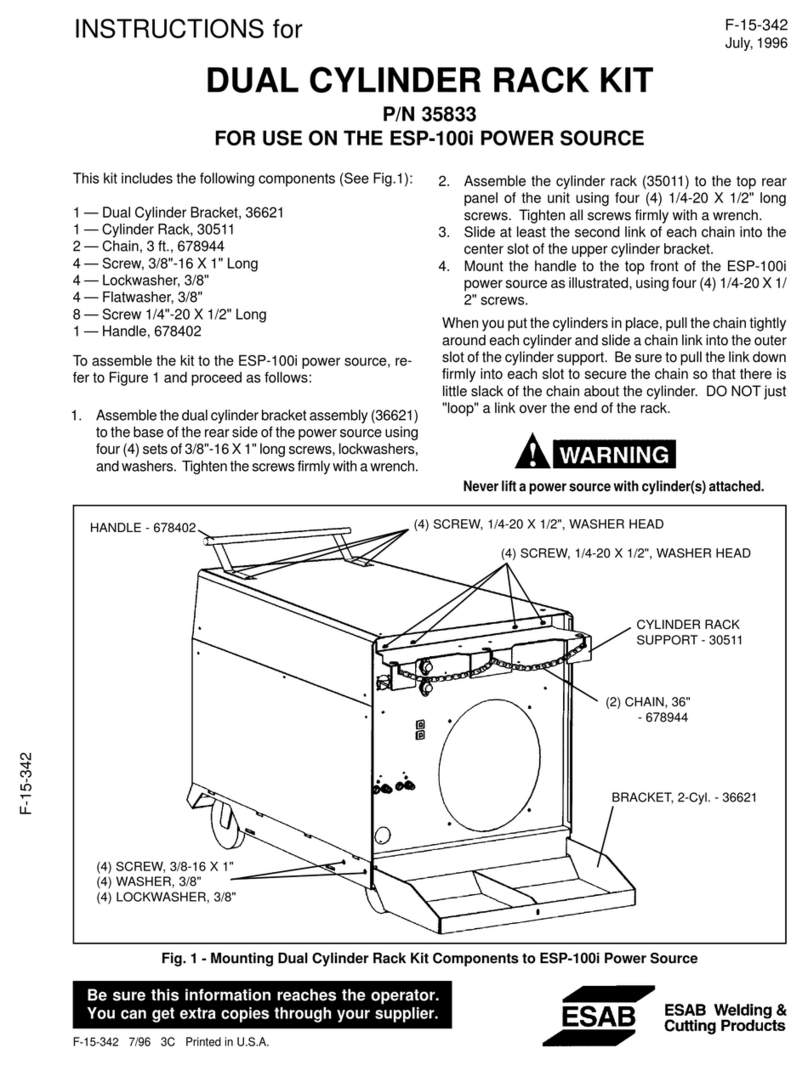
ESAB
ESAB 35833 instructions
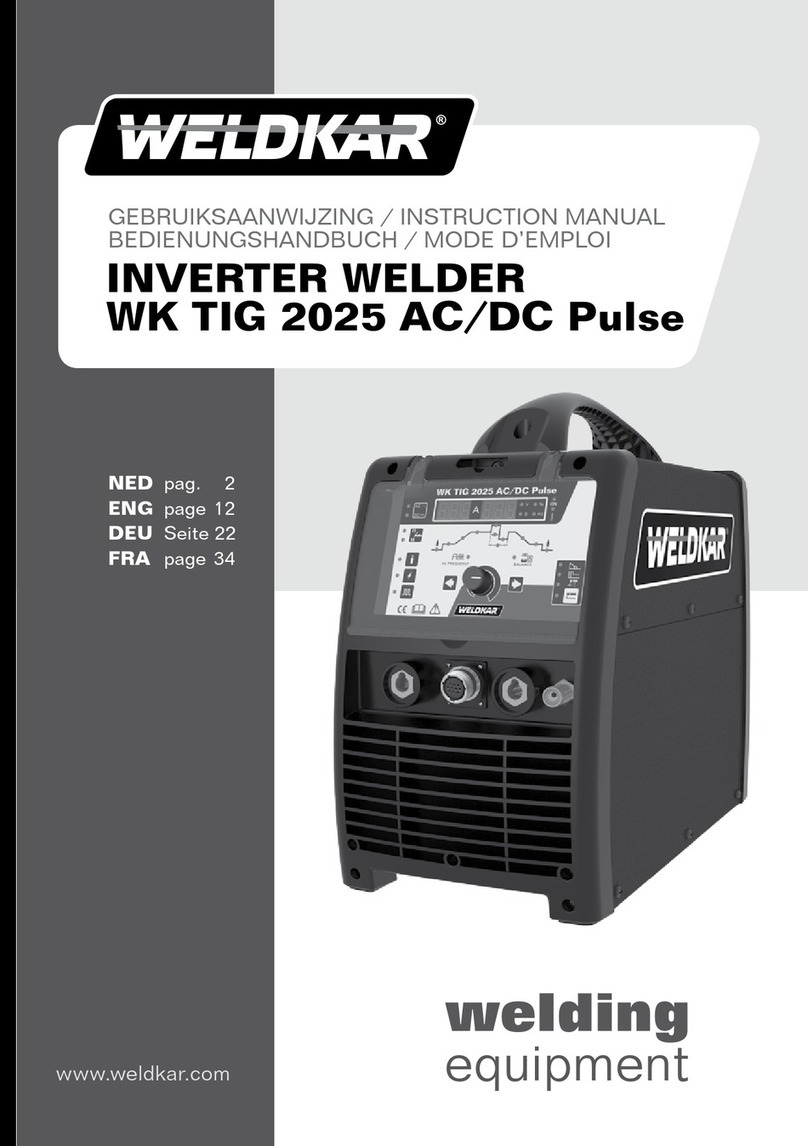
WELDKAR
WELDKAR WK TIG 2025 AC/DC Pulse instruction manual
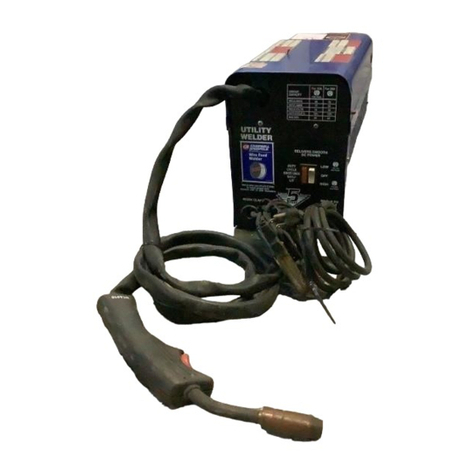
Campbell Hausfeld
Campbell Hausfeld WF1800 Operating instructions & parts manual

Lincoln Electric
Lincoln Electric Square Wave TIG 200 Operator's manual
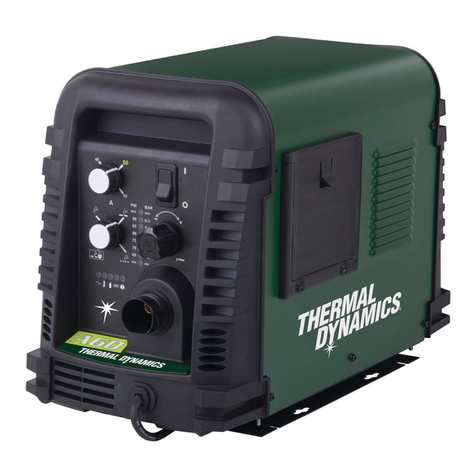
Thermal Dynamics
Thermal Dynamics cutmaster A60 Service manual

Miller Electric
Miller Electric SHOPMATE 300 DX Brochure & specs



